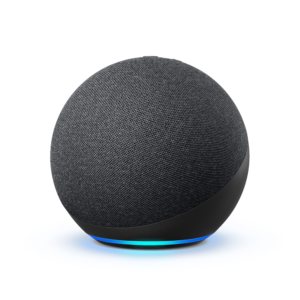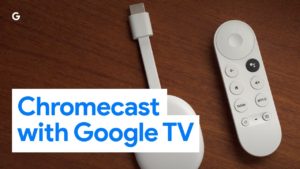Apple, Google and Amazon create home theatre setups around their platforms
| Apple | Amazon | Google (coming soon) | |
| Set-top device | Apple TV (tvOS 11 or newer) | Fire TV Stick Fire TV Cube (2nd Generation or newer) |
Chromecast with Google TV |
| Audio Devices | HomePod or AirPlay-compliant audio devices |
Echo (2nd Generation), Echo Dot (3rd Generation) or newer Echo smart speaker devices | Nest Audio smart speakers |

The Apple TV set-top box – part of a HomePod / AirPlay enhanced audio setup for online video content
Apple, Amazon and Google have or are establishing audio-video platforms based around their smart speaker and set-top devices. This is in order to allow you to stream the audio content from video you are watching through their companion audio devices.
The idea with these setups is to “gang” the platform-based set-top box and the speakers together to provide improved TV sound for online services like Netflix. Some like Amazon describe this approach as home theatre but what happens is that if you have a pair of like speakers ganged with the set-top device, you have stereo sound with increased separation at least. It is based around these companies building it to their platforms the ability for users to have two like speakers in one room set up as a stereo pair for that same goal. Amazon’s setup also allows you to use their Echo Sub subwoofer module to improve the bass response of their setup.

These new Amazon Echo speakers can work as part of an enhanced-audio setup for the Amazon Fire TV set-top platform
It is in addition to being able to stream the sound from an online video source you are watching using these set-top devices to a smart speaker of the same platform for remote listening.
The current limitation with these setups is that they only work with online sources provided by the set-top device that is the hub of the setup. This is because neither of these devices support HDMI-ARC functionality in any way, which allows sound from the TV’s own tuner or video peripherals connected to the TV to be played via a compliant audio device.
These companies who are part of the Silicon Valley establishment see the fashionable way to watch TV content is to use online video-on-demand services facilitated by their own set-top devices. But some user classes would benefit from HDMI-ARC support in many ways.
For example, the TV’s own tuner is still relevant in UK, Europe, Oceania and some other countries due to these areas still placing value on free-to-air broadcast TV. This is centred around the ingrained experience of switching between channels using the TV’s own remote control with the attendant quick response when you change channels. It is also becoming relevant to North America as cord-cutting picks up steam amongst young people and they look towards the TV’s own tuner alongside an indoor antenna to pick up local TV services for current news or local sport.
As well, some users maintain the use of other video-peripheral devices with their TVs. This will apply to people who play games on their TV using a computer or games console, watch content on packaged media like DVDs, use PVR devices to record TV content or subscribe to traditional pay TV that uses a set-top box.
It will be interesting to see whether this operating concept regarding set-top devices and smart speakers that is driven by Apple, Google and Amazon will be developed further. Here this could exist in the form of set-top devices and platforms that are engineered further for things like HDMI-ARC or surround sound.
There will also be the question about whether these setups will ever displace soundbars or fully-fledged home-theatre setups for improved TV sound. On the other hand, they could be placed as a platform-driven entry-level approach for this same goal.

